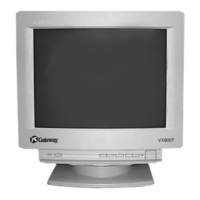
Do you have a question about the Gateway VX900T and is the answer not in the manual?
| Screen Size | 19 inches |
|---|---|
| Panel Type | TN |
| Contrast Ratio | 700:1 |
| Response Time | 5 ms |
| Horizontal Viewing Angle | 160 degrees |
| Vertical Viewing Angle | 160 degrees |
| Connectors | VGA |
Describes the monitor's power saving states, consumption, and indicator lights.
Explains how the self-diagnosis function indicates failures via LED patterns.
Essential safety checks performed after servicing to ensure safe operation.
Method and limits for testing AC leakage current for safety.
Warning about critical safety components requiring specific replacements.
Important warnings and advice regarding power cord connection and usage.
Procedures for resetting specific or all monitor adjustments to factory defaults.
Explanation of monitor warning messages and thin lines on screen.
Guidance for resolving common problems like no picture or signal issues.
Solutions for fuzzy pictures, ghosting, color uniformity, and moire patterns.
Steps for removing the monitor cabinet and internal circuit boards.
Detailed instructions for safely removing the picture tube assembly.
Precautions and procedures for safely removing and handling the anode cap.
Procedures for checking HV regulator and hold-down circuit functionality.
Verification of beam protector logic and maximum B+ voltage.
Detailed steps for performing digital convergence adjustments.
Correction notice for the Digital Convergence Adjustment section of the service manual.
Steps for adjusting H-STAT, V-STAT, HMC, VMC, H-TILT, and XCV for Area A.
Steps for adjusting H-TILT, XCV for Area B and static convergence for Area C.
Detailed steps for adjusting dynamic convergence across different screen areas.
